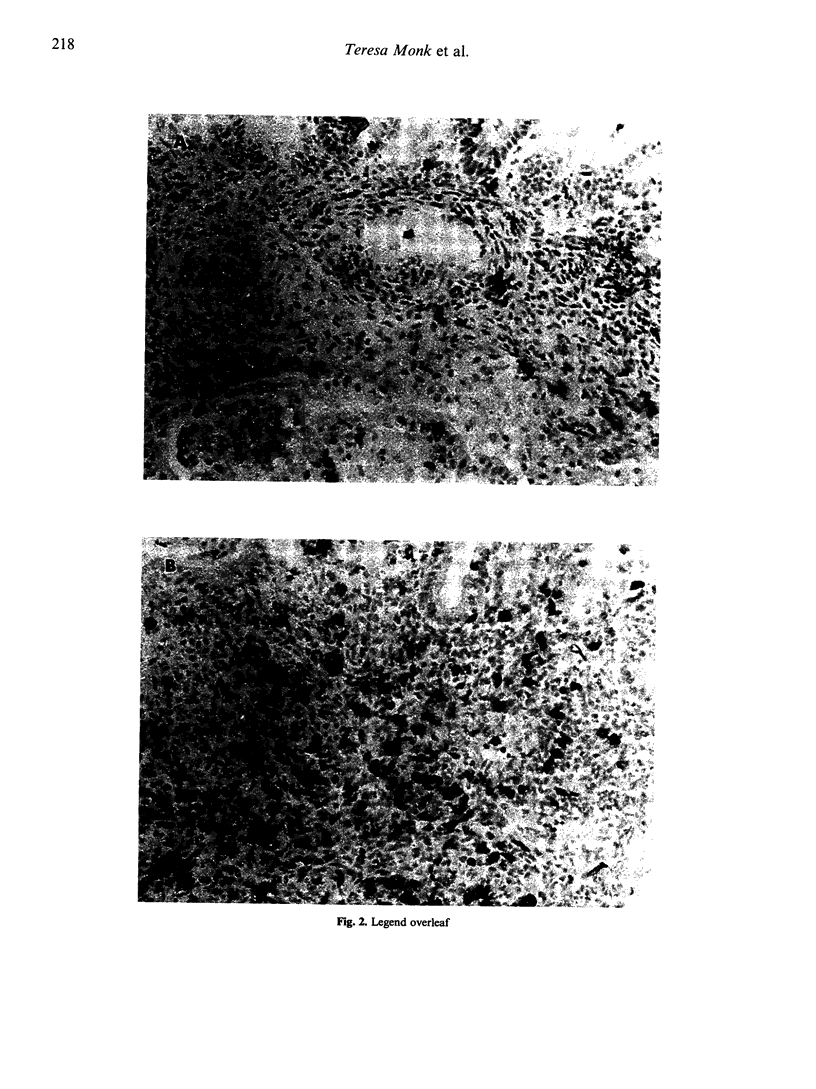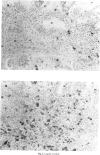Abstract
Mucosal T cells in explants of human fetal small intestine (17-20 weeks gestation) in organ culture were activated in situ using monoclonal anti-CD3 antibody. Changes in the distribution of T cells within the mucosa, and their phenotype, were monitored by immunohistochemistry on frozen sections. Anti-CD3 stimulated T cells (as determined by expression of CD25) were predominantly in the lamina propria and were rarely seen in the epithelium. In control cultures, after 72 h, CD3+ IEL decreased to low numbers compared to day zero. However, in cultures treated with anti-CD3, IEL numbers were maintained and in some experiments significantly increased compared to day zero levels. At onset of culture 50-60% of CD3+ IEL were CD4-, 8-, and virtually all were HML-1+. The T cell infiltrate into the epithelium induced by activation of lamina propria T cells with anti-CD3 was also mostly CD3+, 4-, 8-, HML-1+. These experiments provide strong evidence that increases in IEL numbers can be a consequence of lamina propria T cell activation.
Full text
PDF






Images in this article
Selected References
These references are in PubMed. This may not be the complete list of references from this article.
- BRIDGES R. A., CONDIE R. M., ZAK S. J., GOOD R. A. The morphologic basis of antibody formation development during the neonatal period. J Lab Clin Med. 1959 Mar;53(3):331–357. [PubMed] [Google Scholar]
- Cerf-Bensussan N., Jarry A., Brousse N., Lisowska-Grospierre B., Guy-Grand D., Griscelli C. A monoclonal antibody (HML-1) defining a novel membrane molecule present on human intestinal lymphocytes. Eur J Immunol. 1987 Sep;17(9):1279–1285. doi: 10.1002/eji.1830170910. [DOI] [PubMed] [Google Scholar]
- Ceuppens J. L., Meurs L., Van Wauwe J. P. Failure of OKT3 monoclonal antibody to induce lymphocyte mitogenesis: a familial defect in monocyte helper function. J Immunol. 1985 Mar;134(3):1498–1502. [PubMed] [Google Scholar]
- Crabbé P. A., Nash D. R., Bazin H., Eyssen H., Heremans J. F. Immunohistochemical observations on lymphoid tissues from conventional and germ-free mice. Lab Invest. 1970 May;22(5):448–457. [PubMed] [Google Scholar]
- Ferguson A. Intraepithelial lymphocytes of the small intestine. Gut. 1977 Nov;18(11):921–937. doi: 10.1136/gut.18.11.921. [DOI] [PMC free article] [PubMed] [Google Scholar]
- Ferguson A., Murray D. Quantitation of intraepithelial lymphocytes in human jejunum. Gut. 1971 Dec;12(12):988–994. doi: 10.1136/gut.12.12.988. [DOI] [PMC free article] [PubMed] [Google Scholar]
- Ferguson A., Parrott D. M. The effect of antigen deprivation on thymus-dependent and thymus-independent lymphocytes in the small intestine of the mouse. Clin Exp Immunol. 1972 Dec;12(4):477–488. [PMC free article] [PubMed] [Google Scholar]
- Hancock W. W., Muller W. A., Cotran R. S. Interleukin 2 receptors are expressed by alveolar macrophages during pulmonary sarcoidosis and are inducible by lymphokine treatment of normal human lung macrophages, blood monocytes, and monocyte cell lines. J Immunol. 1987 Jan 1;138(1):185–191. [PubMed] [Google Scholar]
- Holter W., Goldman C. K., Casabo L., Nelson D. L., Greene W. C., Waldmann T. A. Expression of functional IL 2 receptors by lipopolysaccharide and interferon-gamma stimulated human monocytes. J Immunol. 1987 May 1;138(9):2917–2922. [PubMed] [Google Scholar]
- Janossy G., Tidman N., Selby W. S., Thomas J. A., Granger S., Kung P. C., Goldstein G. Human T lymphocytes of inducer and suppressor type occupy different microenvironments. Nature. 1980 Nov 6;288(5786):81–84. doi: 10.1038/288081a0. [DOI] [PubMed] [Google Scholar]
- Lanier L. L., Federspiel N. A., Ruitenberg J. J., Phillips J. H., Allison J. P., Littman D., Weiss A. The T cell antigen receptor complex expressed on normal peripheral blood CD4-, CD8- T lymphocytes. A CD3-associated disulfide-linked gamma chain heterodimer. J Exp Med. 1987 Apr 1;165(4):1076–1094. doi: 10.1084/jem.165.4.1076. [DOI] [PMC free article] [PubMed] [Google Scholar]
- MacDonald T. T., Ferguson A. Small intestinal epithelial cell kinetics and protozoal infection in mice. Gastroenterology. 1978 Mar;74(3):496–500. [PubMed] [Google Scholar]
- MacDonald T. T., Spencer J. Evidence that activated mucosal T cells play a role in the pathogenesis of enteropathy in human small intestine. J Exp Med. 1988 Apr 1;167(4):1341–1349. doi: 10.1084/jem.167.4.1341. [DOI] [PMC free article] [PubMed] [Google Scholar]
- Mathan M., Mathan V. I., Baker S. J. An electron-microscopic study of jejunal mucosal morphology in control subjects and in patients with tropical sprue in southern India. Gastroenterology. 1975 Jan;68(1):17–32. [PubMed] [Google Scholar]
- Phillips A. D., Rice S. J., France N. E., Walker-Smith J. A. Small intestinal intraepithelial lymphocyte levels in cow's milk protein intolerance. Gut. 1979 Jun;20(6):509–512. doi: 10.1136/gut.20.6.509. [DOI] [PMC free article] [PubMed] [Google Scholar]
- Spencer J., Dillon S. B., Isaacson P. G., MacDonald T. T. T cell subclasses in fetal human ileum. Clin Exp Immunol. 1986 Sep;65(3):553–558. [PMC free article] [PubMed] [Google Scholar]
- Spencer J., MacDonald T. T., Isaacson P. G. Heterogeneity of non-lymphoid cells expressing HLA-D region antigens in human fetal gut. Clin Exp Immunol. 1987 Feb;67(2):415–424. [PMC free article] [PubMed] [Google Scholar]
- Van Wauwe J. P., De Mey J. R., Goossens J. G. OKT3: a monoclonal anti-human T lymphocyte antibody with potent mitogenic properties. J Immunol. 1980 Jun;124(6):2708–2713. [PubMed] [Google Scholar]





